The chinese algae eater, commonly known as the golden algae eater, is a freshwater fish celebrated for its ability to help control algae growth in aquariums. While this fish is often praised as a diligent tank cleaner in its youth, the reality can be quite different as it matures.
Initially, the golden algae eater is an enthusiastic scavenger, tirelessly grazing on algae and contributing to the cleanliness of its environment. However, as it grows into adulthood, its dietary preferences shift. Many adult golden algae eaters develop a taste for live food and may even start to nip at the scales of their tank mates.
To ensure a harmonious aquarium, it’s crucial to monitor the behavior of this fish as it matures. Providing a varied diet that includes both algae and high-quality pellets can help mitigate aggressive tendencies. Understanding these changes will allow tank owners to appreciate both the benefits and challenges of keeping a golden algae eater.
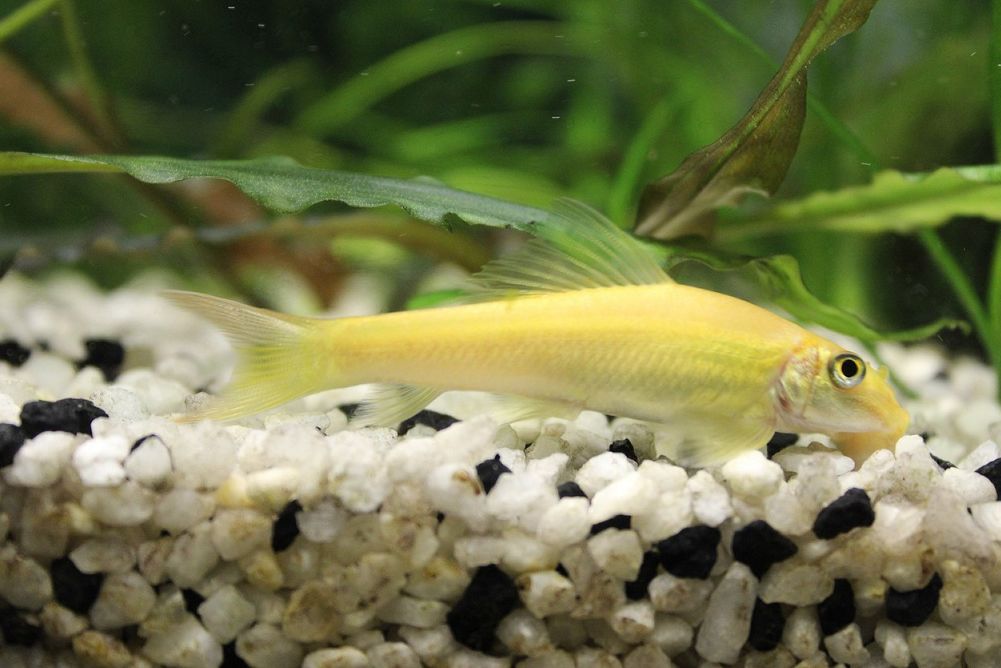
Contents
Habitat in the wild
The chinese algae eater, scientifically known as Gyrinocheilus aymonieri, belongs to the family Gyrinocheilidae, commonly referred to as the sucking loach family. This small group of freshwater fish is native to Southeast Asia and consists of just three recognized species: gyrinocheilus aymonieri, gyrinocheilus pennocki, and gyrinocheilus pustulosus.
The name “chinese algae eater” is somewhat misleading, as these fish do not inhabit China. They are primarily found in the mountain streams and lakes of Thailand, Laos, Cambodia, Vietnam, and the Kalimantan peninsula. The golden algae eater prefers fast-flowing waters with rocky bottoms, often filled with stones, pebbles, gravel, and sand, as well as areas around flooded trees and their roots. They are known for their seasonal migrations, during which they may venture into muddier waters and flooded coastal regions.
The name gyrinocheilus comes from the Greek words “gyrinos,” meaning “tadpole,” and “cheilos,” meaning “lip,” referencing the fish’s triangular mouth shape. The species was first scientifically described in 1883, with “aymonieri” honoring the French linguist Étienne François Aymonier (1844–1929).
In the wild, the golden algae eater can grow up to 10–12 inches (25–30 cm) long, making it a significant presence in its habitat. Unlike many aquarium species, this fish is primarily valued for trade rather than ornamental purposes. In captivity, it is essential to replicate its natural environment and provide plenty of algae, as it primarily feeds on various forms of algae and detritus. This understanding of its natural history will help aquarium enthusiasts provide the best care for this unique fish.
Description
Body
The chinese algae eater features a streamlined, elongated body that resembles that of a loach or catfish, tapering towards the tail. This fish has a compressed body and an inferior sucker mouth that allows it to adhere to surfaces and effectively scrape algae from rocks and plants.
One of its distinctive adaptations is its two branchial apertures, which enable water to flow in and wash over its gills. This unique physiological trait frees the fish’s mouth from the need to breathe while it feeds, allowing it to focus solely on cutting algae from various surfaces. The mouth is equipped with pronounced lips and acts as a sucker, lined with rigid, coarse lamellas that enhance its algae-scraping capabilities. This combination of features makes the golden algae eater an efficient and fascinating addition to any freshwater aquarium.
Color
The natural coloring of Gyrinocheilus aymonieri can vary significantly. Wild specimens typically display a pale clay color adorned with a reticulate pattern and a prominent dark lateral stripe, which often breaks into a series of spots along the body. In contrast, tank-raised individuals, particularly the golden algae eater and the albino algae eater, showcase a striking solid yellow coloration.
This vibrant hue is the most distinctive feature setting these tank varieties apart from their wild counterparts. While the coloration may differ, the essential characteristics and behavior of these fish remain consistent, making them a popular choice among aquarium enthusiasts. Understanding these color variations can enhance appreciation for this species and inform care practices to ensure their health and vitality.
Lifespan
The lifespan of the chinese algae eater typically ranges from 5 to 10 years when provided with optimal care. Understanding the factors that influence their longevity is essential for aquarium enthusiasts. Water quality plays a crucial role, as clean, well-maintained environments contribute significantly to their health.
A balanced diet rich in algae and other appropriate foods, along with an adequately sized tank that allows for natural behaviors, can also enhance their lifespan. Additionally, genetics can influence individual resilience and health. By addressing these factors, tank owners can help ensure that their golden algae eaters thrive for many years, maximizing the enjoyment and beauty they bring to the aquarium.
Size
The chinese algae eater is a relatively large freshwater fish. In its natural habitat, it can reach impressive lengths of up to 11 inches (28 cm). However, when kept in an aquarium, its size typically averages around 6 inches (15 cm). This difference in size is often influenced by environmental factors such as tank conditions, diet, and overall care. By providing a spacious and well-maintained environment, aquarium owners can help their golden algae eaters grow to their full potential, making them a striking addition to any tank.
Growth rate
The chinese algae eater has the potential for rapid growth during its early development stages. In optimal conditions, including a nutritious diet and high water quality, these fish can grow several inches within their first year. However, it’s important to note that their growth rate slows as they approach maturity.
While chinese algae eaters are often sold at smaller sizes in the aquarium trade, they can ultimately reach a maximum length of around 10 inches (25 cm) when fully grown. This potential size underscores the necessity of providing a spacious tank that accommodates their growth. Planning ahead for their adult size is crucial to ensure a healthy and comfortable environment for these fascinating fish.
| Characteristic | Description |
|---|---|
| Common Name | Chinese Algae Eater, golden algae eater, albino algae eater, yellow algae eater, chinese sucker fish |
| Scientific Name | Gyrinocheilus aymonieri |
| Family | Gyrinocheilidae |
| Native Region | Southeast Asia (China, Thailand, Laos, Vietnam, Cambodia) |
| Habitat | Slow-moving rivers, streams, and heavily vegetated areas |
| Maximum Size | Up to 10 inches (25 cm) in length |
| Lifespan | Around 5-10 years |
| Temperament | Generally peaceful, but can become territorial/aggressive |
| Diet | Primarily algae and detritus, may eat other foods as well |
| Water Temperature | 75-82°F (24-28°C) |
| Water pH | Slightly acidic to neutral (preferably on the softer side) |
| Tank Size | Spacious tank with ample swimming space |
| Compatibility | Can be aggressive towards other bottom-dwelling species |
| Recommended Tank Setup | Live or artificial plants, hiding spots, good water filtration |
| Algae Control | Effective at controlling algae when young, less effective as it matures |
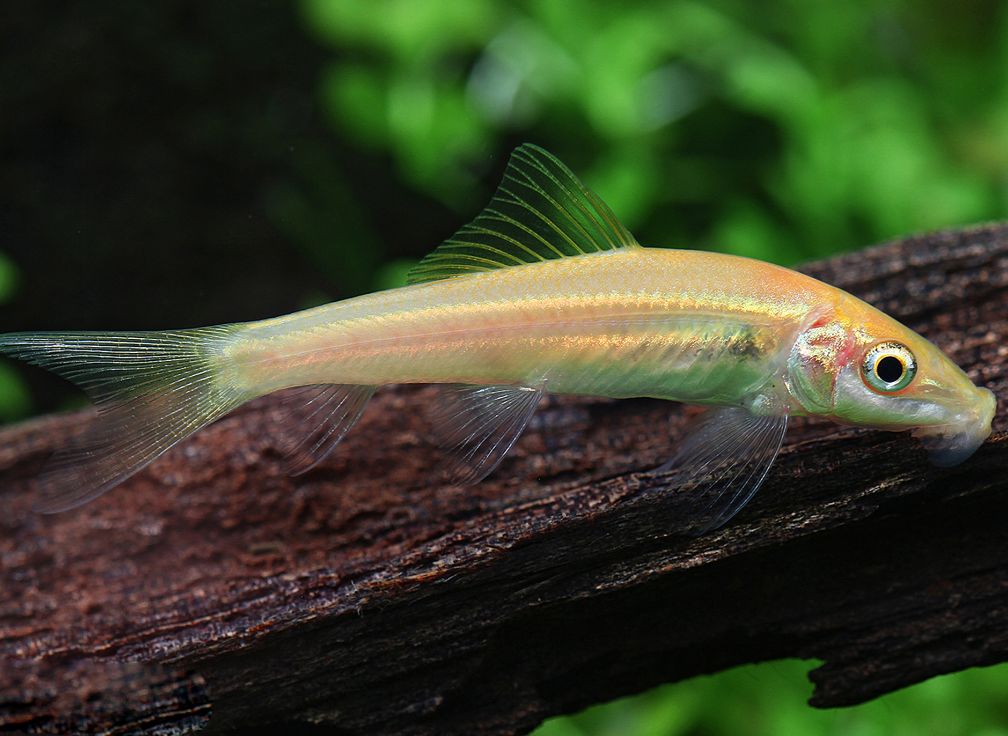
Chinese Algae Eater vs Siamese Algae Eater
The chinese algae eater is often confused with the siamese algae eater, but these are two distinct species with notable differences. The siamese algae eater features a uniquely shaped mouth and a prominent black lateral stripe that runs the length of its body. In contrast, the chinese algae eater can grow significantly larger, reaching lengths of up to 10 inches (25 cm), while the siamese algae eater typically maxes out around 6 inches (15 cm).
Behaviorally, these two species differ as well. Chinese algae eaters can be more aggressive, often becoming food rivals with the more peaceful and timid siamese algae eaters, which may suffer from attacks.
It’s essential to correctly identify these species when purchasing, as they are sometimes mislabeled or confused in the aquarium trade. Ensuring proper identification will help create a harmonious tank environment and support the well-being of all your fish.
| Characteristic | Chinese Algae Eater (Gyrinocheilus aymonieri) | Siamese Algae Eater (Crossocheilus siamensis) |
|---|---|---|
| Appearance | Sleek body, dark coloration, gold stripe | Slender body, black coloration, black stripes |
| Maximum Size | Up to 10 inches (25 cm) | Around 6 inches (15 cm) |
| Aggression/Temperament | Can become aggressive and territorial | Generally peaceful and mild-tempered |
| Algae-Eating Efficiency | Decreases with age, may need supplemental food | Highly effective at consuming various algae |
| Compatibility | Aggressive towards other fish, may damage fins | More compatible with a wide range of tankmates |
| Tank Size | Requires spacious tank due to size and behavior | Suitable for moderate-sized aquariums |
| Algae Types Consumed | Consumes various types of algae | Particularly effective against black beard algae |
| Longevity | Average lifespan of 5-10 years | Average lifespan of 5-7 years |
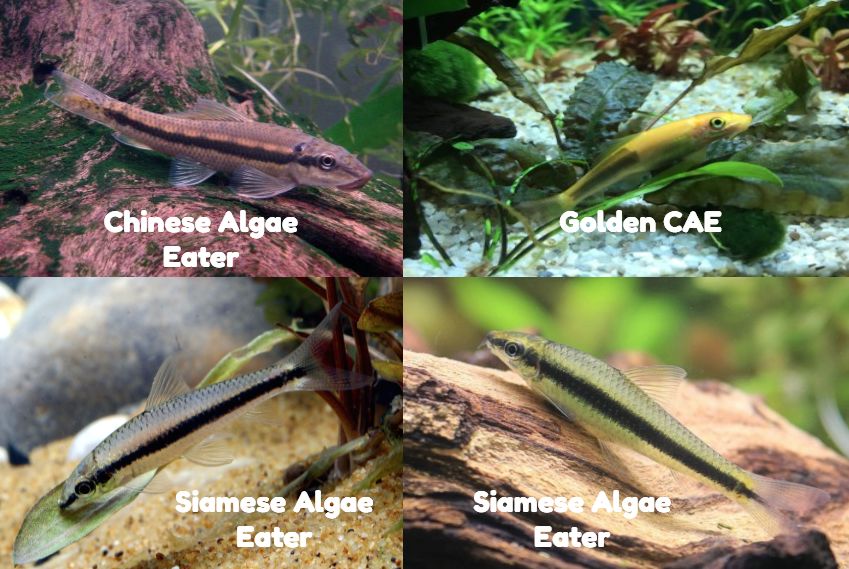
Difficulties in keeping
The chinese algae eater is a great choice for both beginner and experienced aquarists, though there are some important considerations to keep in mind. While these fish are often purchased to help control algae in the tank, they can grow quite large and may not coexist well with other fish of similar size and appearance.
This species thrives in clean water and is sensitive to nitrate levels. If housed with tank mates that are not closely related and provided with clean water, the chinese algae eater can be quite resilient and adaptable to various tank parameters.
However, when it comes to cleaning tank glass and plants, expectations should be tempered. These fish are more likely to graze on algae only when other food options are scarce. If tastier food is available, they will readily join in feeding time with other tank inhabitants, especially as adults, who may completely ignore algae in favor of competing for more palatable options.
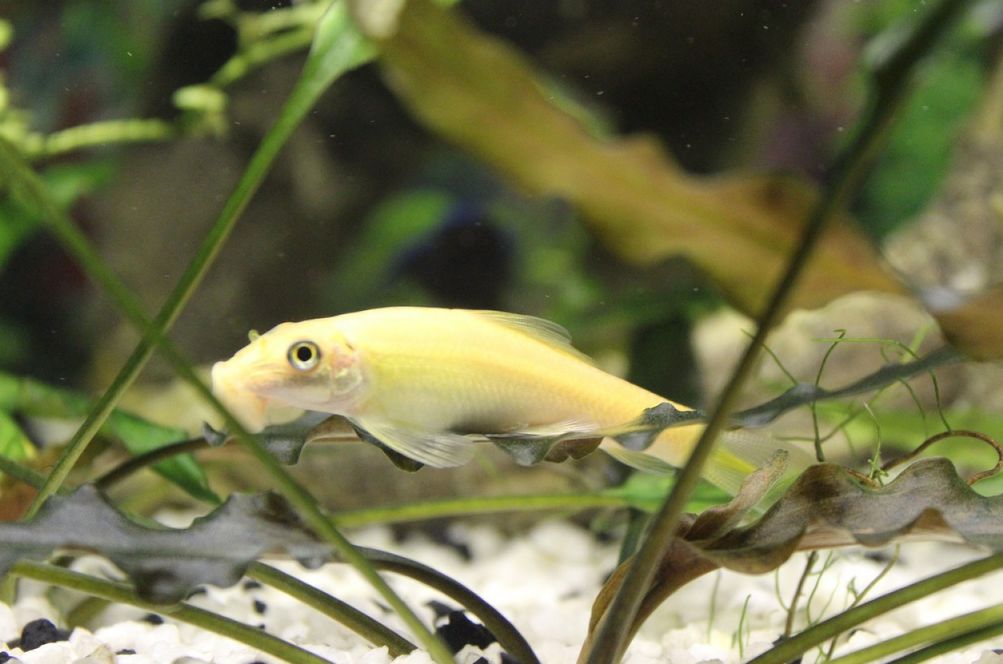
Care and keeping in a tank
Tank size
The chinese algae eater is an active fish that spends much of its time near the bottom of the tank. For juvenile fish, a tank size of at least 22 gallons (100 liters) is sufficient. However, as they grow into adults, a larger tank of 44 gallons (200 liters) or more is essential, particularly if you plan to keep a group of them together.
In addition to size, it’s important to create a suitable environment with a sandy or gravel substrate and plenty of hiding spots to provide security. Given their tendency to jump, a secure cover is necessary to prevent them from escaping the tank.
Water parameters
The chinese algae eater is a robust and adaptable fish, capable of thriving in a wide range of tank conditions. This species is well-suited to various water parameters, with a recommended temperature range of 75–80 °F (24–27 °C), a pH level between 5.8 and 8.0, and a general hardness (dGH) of 3 to 12.
These fish thrive in well-oxygenated water with strong circulation, which mimics their natural habitat. By maintaining optimal water conditions, you can ensure that your chinese algae eaters remain healthy and active in your aquarium.
Tank setup: decorations and plants
The chinese algae eater thrives in an aquarium that offers several shelters and hiding spots. Large stones, ceramic structures, driftwood, and caves make excellent tank decorations, especially when the fish is kept in groups. Providing multiple shelters helps minimize conflicts and promotes a peaceful environment.
Using medium to large round stones as a bottom substrate is beneficial, as they offer convenient surfaces for the fish to scrape algae. Bright lighting is also important, as it encourages algae growth on plants and decorations, providing a constant food source for the fish. In such a well-structured environment, the chinese algae eater will display more natural behaviors and can coexist with many other active species.
A densely planted tank is ideal, as these fish typically do not damage plants. Any type of aquatic vegetation can be included, and when provided with ample plant food, the chinese algae eater is less likely to nibble on the plants themselves, even those with small leaves. A lush array of plants not only enhances the aesthetic of the tank but also serves as natural shelters, further enriching the habitat for your fish.
Filtration
As a species that primarily inhabits mountain rivers, the chinese algae eater thrives in very clean, oxygen-rich water. To replicate this environment in an aquarium, a powerful canister filter is essential. Additionally, creating some water flow in the tank can enhance the fish’s comfort and mimic its natural habitat.
To maintain optimal water quality, it’s important to perform weekly water changes, replacing about 30% of the tank water while also siphoning the bottom substrate. This regular maintenance not only helps to keep the water clean but also ensures a healthy environment for your chinese algae eaters, allowing them to flourish and display their natural behaviors.
Diet
In the wild, the chinese algae eater has a varied diet that includes not only algae and fouling found on stones and plants but also small organisms like maggots. To keep your fish in optimal shape, it’s important to supplement their diet with live or frozen foods occasionally. Options such as bloodworms, daphnia, and brine shrimp can be excellent additions, alongside high-quality dry flakes and pellets.
Offering blanched vegetables like zucchini, cucumber, or spinach can also be beneficial. Ensure these are softened and securely anchored in the tank to prevent them from floating away. For a staple diet, high-quality sinking pellets designed for herbivorous fish are ideal. These pellets sink quickly, maintain their shape, and provide essential nutrients, including fish components, mussels, and spirulina.
Be aware that if your fish are not hungry or are overfed, they may lose interest in algae and cease their cleaning behavior. In addition to the usual live food and flakes, you can also offer spinach, lettuce, and cabbage leaves that have been blanched in boiling water.
While juvenile chinese algae eaters are generally peaceful and effective at cleaning algae, adults may become less diligent and show some aggression. Feed them daily, but if you notice a decline in their algae-eating habits, consider reducing their portions to encourage them to graze more on the tank’s green algae. This approach can help maintain a cleaner environment and ensure the health of your aquarium.
Tank mates
Chinese algae eaters can be kept both alone and in groups, though group dynamics vary significantly with age. Young specimens can thrive in groups, but as they mature, they become more territorial and often do not tolerate the presence of their own kind or similar tank mates. To minimize aggression, it’s generally recommended to keep them either as solitary fish or in small groups. If you choose to keep them in groups, aim for at least 3 to 5 individuals to establish a hierarchy; smaller groups can lead to bullying of weaker fish.
In smaller tanks, it is common to house a single chinese algae eater. Keeping multiple individuals in cramped conditions can result in stress and aggression, often leading to the demise of the weakest fish.
While primarily herbivorous, feeding on algae and detritus, chinese algae eaters can exhibit aggressive behavior, particularly as they grow. They may become territorial and harass slow-swimming or bottom-dwelling tank mates. This aggression is especially pronounced toward fish of similar size and appearance, such as siamese algae eaters.
It’s best to avoid pairing them with large, slow-moving species like goldfish, discus, or angelfish. The chinese algae eater may damage their skin by sucking on them and scraping off their protective slime layer. However, they can be successfully housed in community tanks with active, average-sized tank mates, where their aggressive tendencies are less likely to disrupt the harmony of the aquarium.
- Harlequin Rasboras (Trigonostigma heteromorpha)
- Neon Tetras (Paracheirodon innesi)
- Ember Tetras (Hyphessobrycon amandae)
- Glowlight Tetras (Hemigrammus erythrozonus)
- Black Neon Tetras (Hyphessobrycon herbertaxelrodi)
- Cardinal Tetras (Paracheirodon axelrodi)
- Rummy Nose Tetras (Hemigrammus rhodostomus)
- Dwarf Gouramis (Trichogaster lalius or Trichogaster chuna)
- Sparkling Gouramis (Trichopsis pumila)
- Celestial Pearl Danios (Danio margaritatus)
- White Cloud Mountain Minnows (Tanichthys albonubes)
- Dwarf Rasboras (Boraras spp.)
- Endler’s Livebearers (Poecilia wingei)
- Guppies (Poecilia reticulata)
- Platies (Xiphophorus spp.)
- Corydoras Catfish (Corydoras spp. – pygmy cory, panda cory, adolfoi catfish)
- Otocinclus Catfish (Otocinclus spp.)
- Bristlenose Plecos (Ancistrus spp.)
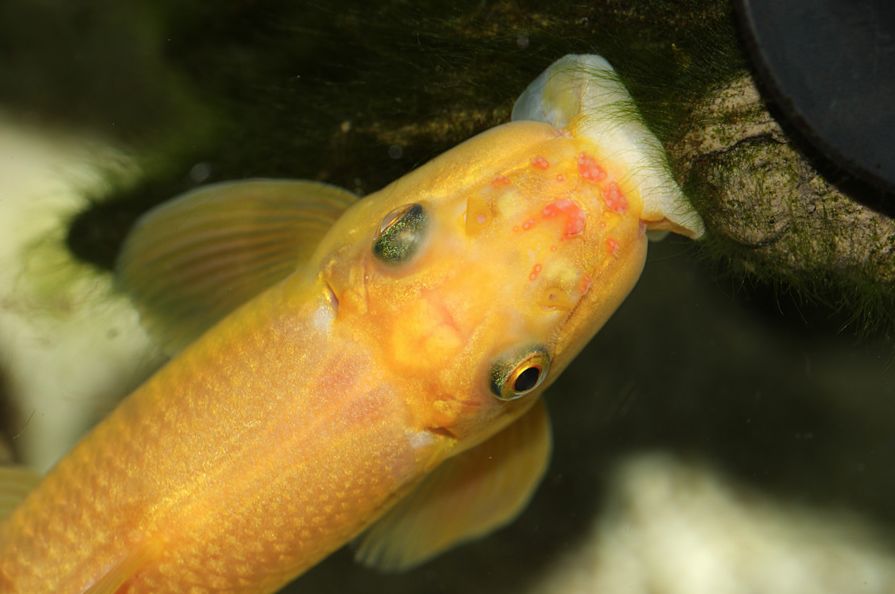
Gender differences: male vs female
Distinguishing between male and female chinese algae eaters can be quite challenging, as they generally look alike. However, adult females tend to be slightly thicker and more rounded than their male counterparts. Despite this difference, identifying the sex of chinese algae eaters is usually not necessary for their care and maintenance in the aquarium. This means you can focus on providing an optimal environment without needing to worry about their gender.
Breeding
Breeding chinese algae eaters in home aquariums can be quite challenging due to their reproductive complexities. Since their introduction to Europe in large numbers in 1955, it has become evident that these fish are not particularly fertile. Today, they are often bred in fish hatcheries using hormonal agents, which complicates at-home breeding efforts.
To successfully breed chinese algae eaters, an aquarist needs experience and knowledge in administering hormonal injections. These fish typically reach reproductive maturity around the age of 2 years. For breeding, a separate tank of at least 200 liters is necessary, equipped with good filtration and strong water flow. It’s helpful to place a net on the bottom and include some wide-leaved plants in the corners. Dim lighting is recommended to create a suitable environment.
Ideal water parameters for breeding include a temperature of 24°C, a pH range of 6.0 to 8.8, and a general hardness (GH) not exceeding 5. Daily water renewal of about 10% is crucial to maintaining optimal conditions.
To initiate breeding, two hormonal injections are given to the selected female: the first before spawning and the second when placing her in the breeding tank with two males. A single female can lay up to 3,000 eggs, which the males will then fertilize. After spawning, it’s important to remove the adult fish from the tank to protect the eggs.
Ongoing care for the eggs is critical and involves daily water renewals and the removal of any dead eggs. Adding antifungal agents can also help preserve more embryos. The incubation period lasts about a day, and the juveniles grow rapidly without showing cannibalistic tendencies toward their siblings, making the breeding process a rewarding endeavor for dedicated aquarists.